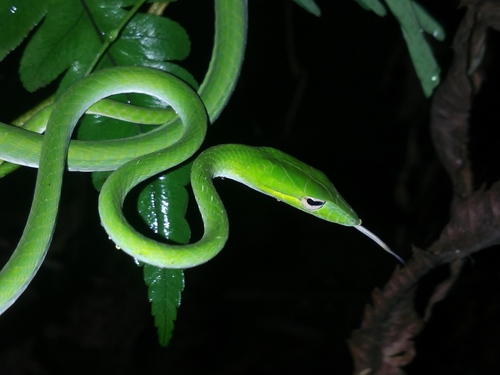
Oriental Whip Snake
The Oriental vine snake, Ahaetulla prasina, is a vibrant green and highly camouflaged serpent with a distinctive pointy snout. Found in Southeast Asian forests, it skillfully hunts lizards and frogs by day, seamlessly blending with the leaves, highlighting nature's artistry in adaptation and predation.
5-12 years
Lifespan
Length: 76 - 152 cm
Size
Yellow, Blue, Green
Color
Low
Aggression
Least Concern
Conservation Status
Stable
Population Trend
Characteristics
Ahaetulla prasina, commonly known as the Oriental vine snake, is a slender, green tree-dwelling snake native to Southeast Asia. It exhibits a remarkable ability to change color slightly to blend with foliage. Known for its excellent camouflage, it has a long, pointed snout and horizontal pupils. This diurnal predator feeds primarily on lizards and frogs, playing a crucial role in controlling these populations within its ecosystem.
Distribution Range of the Oriental Whip Snake
Ahaetulla prasina, commonly known as the Oriental Whip Snake, is native to Southeast Asia. Its geographical distribution includes countries such as India, Sri Lanka, Bangladesh, Myanmar, Thailand, Laos, Vietnam, Cambodia, Malaysia, Singapore, Indonesia, and the Philippines.
Oriental Whip Snake's Habitat
Environmental Conditions
The Oriental Whip Snake typically inhabits tropical and subtropical forests, including rainforests and mangrove forests. It is also found in agricultural areas, gardens, and plantations that provide adequate vegetation. The climate in these regions is generally warm and humid, with significant rainfall throughout the year.
Ecological Niche
Ahaetulla prasina is an arboreal species, primarily residing in trees and shrubs where it hunts for prey such as lizards, amphibians, and small birds. Its slender, green body provides excellent camouflage among foliage, making it well-adapted to life in dense vegetation. This snake plays a role in controlling pest populations in its ecosystem.
Copyright @ Nature Style Limited. All Rights Reserved.
 English
English